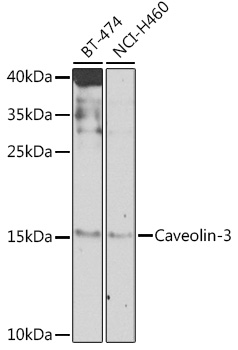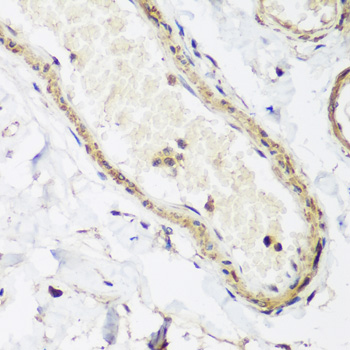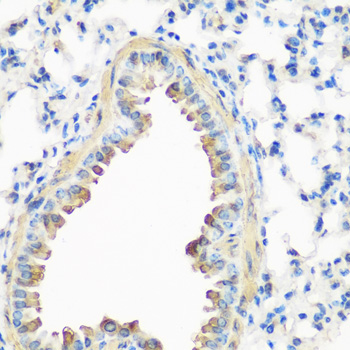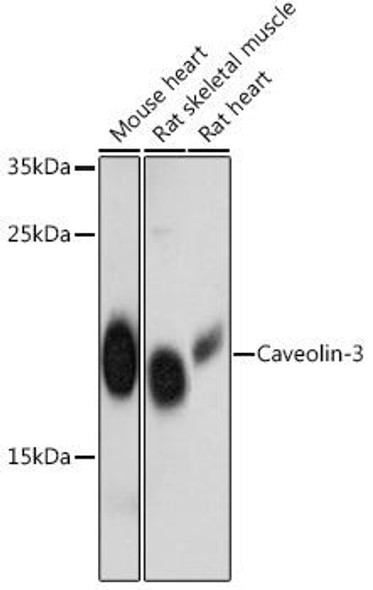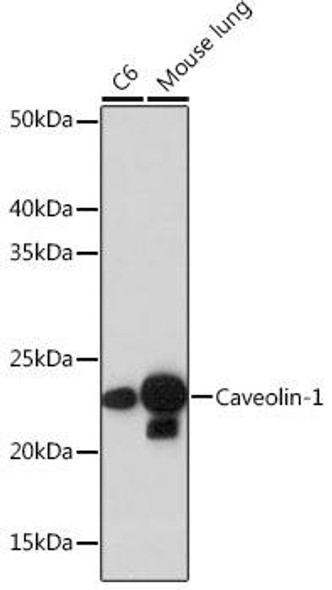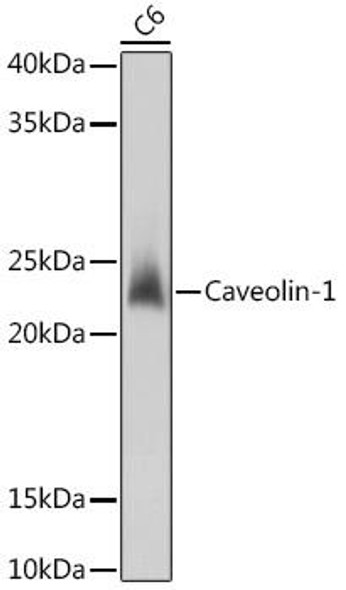Cell Biology Antibodies 11
Anti-Caveolin-3 Antibody (CAB8089)
- SKU:
- CAB8089
- Product Type:
- Antibody
- Applications:
- WB
- Applications:
- IHC
- Reactivity:
- Human
- Reactivity:
- Mouse
- Reactivity:
- Rat
- Host Species:
- Rabbit
- Isotype:
- IgG
- Research Area:
- Cell Biology
Description
| Antibody Name: | Caveolin-3 Rabbit Polyclonal Antibody |
| Antibody SKU: | CAB8089 |
| Antibody Size: | 20uL, 50uL, 100uL |
| Application: | WB IHC |
| Reactivity: | Human, Mouse |
| Host Species: | Rabbit |
| Immunogen: | Recombinant fusion protein containing a sequence corresponding to amino acids 1-151 of human Caveolin-3 (NP_001225.1). |
| Application: | WB IHC |
| Recommended Dilution: | WB 1:500 - 1:2000 IHC 1:50 - 1:200 |
| Reactivity: | Human, Mouse |
| Positive Samples: | BT-474, NCI-H460 |
| Immunogen: | Recombinant fusion protein containing a sequence corresponding to amino acids 1-151 of human Caveolin-3 (NP_001225.1). |
| Purification Method: | Affinity purification |
| Storage Buffer: | Store at -20'C. Avoid freeze / thaw cycles. Buffer: PBS with 0.02% sodium azide, 50% glycerol, pH7.3. |
| Isotype: | IgG |
| Sequence: | MMAE EHTD LEAQ IVKD IHCK EIDL VNRD PKNI NEDI VKVD FEDV IAEP VGTY SFDG VWKV SYTT FTVS KYWC YRLL STLL GVPL ALLW GFLF ACIS FCHI WAVV PCIK SYLI EIQC ISHI YSLC IRTF CNPL FAAL GQVC SSIK VVLR KEV |
| Gene ID: | 859 |
| Uniprot: | P56539 |
| Cellular Location: | Cell membrane, Golgi apparatus membrane, Membrane, Peripheral membrane protein, caveola |
| Calculated MW: | 17kDa |
| Observed MW: | 17kDa |
| Synonyms: | CAV3, LGMD1C, LQT9, VIP-21, VIP21 |
| Background: | This gene encodes a caveolin family member, which functions as a component of the caveolae plasma membranes found in most cell types. Caveolin proteins are proposed to be scaffolding proteins for organizing and concentrating certain caveolin-interacting molecules. Mutations identified in this gene lead to interference with protein oligomerization or intra-cellular routing, disrupting caveolae formation and resulting in Limb-Girdle muscular dystrophy type-1C (LGMD-1C), hyperCKemia or rippling muscle disease (RMD). Alternative splicing has been identified for this locus, with inclusion or exclusion of a differentially spliced intron. In addition, transcripts utilize multiple polyA sites and contain two potential translation initiation sites. |
| UniProt Protein Function: | caveolin-3: May act as a scaffolding protein within caveolar membranes. Interacts directly with G-protein alpha subunits and can functionally regulate their activity. May also regulate voltage-gated potassium channels. Plays a role in the sarcolemma repair mechanism of both skeletal muscle and cardiomyocytes that permits rapid resealing of membranes disrupted by mechanical stress. Defects in CAV3 are the cause of limb-girdle muscular dystrophy type 1C (LGMD1C). LGMD1C is a myopathy characterized by calf hypertrophy and mild to moderate proximal muscle weakness. LGMD1C inheritance can be autosomal dominant or recessive. Defects in CAV3 are a cause of hyperCKmia (HYPCK). It is a disease characterized by persistent elevated levels of serum creatine kinase without muscle weakness. Defects in CAV3 are a cause of rippling muscle disease (RMD). RMD is a rare disorder characterized by mechanically triggered contractions of skeletal muscle. In RMD, mechanical stimulation leads to electrically silent muscle contractions that spread to neighboring fibers that cause visible ripples to move over the muscle. Defects in CAV3 are a cause of familial hypertrophic cardiomyopathy (CMH); also designated FHC or HCM. Familial hypertrophic cardiomyopathy is a hereditary heart disorder characterized by ventricular hypertrophy, which is usually asymmetric and often involves the interventricular septum. The symptoms include dyspnea, syncope, collapse, palpitations, and chest pain. They can be readily provoked by exercise. The disorder has inter- and intrafamilial variability ranging from benign to malignant forms with high risk of cardiac failure and sudden cardiac death. Defects in CAV3 are the cause of long QT syndrome type 9 (LQT9). Long QT syndromes are heart disorders characterized by a prolonged QT interval on the ECG and polymorphic ventricular arrhythmias. They cause syncope and sudden death in response to excercise or emotional stress. They can present with a sentinel event of sudden cardiac death in infancy. Defects in CAV3 can be a cause of sudden infant death syndrome (SIDS). SIDS is the sudden death of an infant younger than 1 year that remains unexplained after a thorough case investigation, including performance of a complete autopsy, examination of the death scene, and review of clinical history. Pathophysiologic mechanisms for SIDS may include respiratory dysfunction, cardiac dysrhythmias, cardiorespiratory instability, and inborn errors of metabolism, but definitive pathogenic mechanisms precipitating an infant sudden death remain elusive. Long QT syndromes-associated mutations can be responsible for some SIDS cases. Defects in CAV3 are the cause of myopathy distal Tateyama type (MPDT). A disorder characterized by progressive muscular atrophy and muscle weakness beginning in the hands, the legs, or the feet. Muscle atrophy may be restricted to the small muscles of the hands and feet. Belongs to the caveolin family. |
| UniProt Protein Details: | Protein type:Dystrophin complex; Extracellular matrix; Motility/polarity/chemotaxis; Cell development/differentiation Chromosomal Location of Human Ortholog: 3p25 Cellular Component: Golgi membrane; dystrophin-associated glycoprotein complex; cell surface; endoplasmic reticulum; T-tubule; plasma membrane; caveola; Z disc; neuromuscular junction; sarcolemma; vesicle; lipid raft Molecular Function:protein C-terminus binding; protein binding; sodium channel regulator activity; calcium channel regulator activity; protein complex binding; protein complex scaffold; nitric-oxide synthase binding; potassium channel inhibitor activity; alpha-tubulin binding Biological Process: negative regulation of MAP kinase activity; muscle development; positive regulation of microtubule polymerization; T-tubule organization and biogenesis; negative regulation of cell size; glucose homeostasis; cytoplasmic microtubule organization and biogenesis; regulation of heart contraction; muscle maintenance; protein localization; elevation of cytosolic calcium ion concentration; cardiac muscle cell development; regulation of transforming growth factor beta receptor signaling pathway; plasma membrane organization and biogenesis; regulation of skeletal muscle contraction; positive regulation of cell proliferation; cell growth; cell differentiation; myoblast fusion; regulation of nerve growth factor receptor activity; negative regulation of calcium ion transport; negative regulation of nitric-oxide synthase activity; negative regulation of MAPKKK cascade; regulation of heart rate; actin filament organization; endocytosis; regulation of protein kinase B signaling cascade; nucleus localization; cholesterol homeostasis; regulation of membrane potential; triacylglycerol metabolic process; plasma membrane repair; negative regulation of protein kinase activity; lipid raft organization and biogenesis Disease: Creatine Phosphokinase, Elevated Serum; Long Qt Syndrome 9; Rippling Muscle Disease; Muscular Dystrophy, Limb-girdle, Type 1c; Myopathy, Distal, Tateyama Type; Cardiomyopathy, Familial Hypertrophic, 1 |
| NCBI Summary: | This gene encodes a caveolin family member, which functions as a component of the caveolae plasma membranes found in most cell types. Caveolin proteins are proposed to be scaffolding proteins for organizing and concentrating certain caveolin-interacting molecules. Mutations identified in this gene lead to interference with protein oligomerization or intra-cellular routing, disrupting caveolae formation and resulting in Limb-Girdle muscular dystrophy type-1C (LGMD-1C), hyperCKemia or rippling muscle disease (RMD). Alternative splicing has been identified for this locus, with inclusion or exclusion of a differentially spliced intron. In addition, transcripts utilize multiple polyA sites and contain two potential translation initiation sites. [provided by RefSeq, Jul 2008] |
| UniProt Code: | P56539 |
| NCBI GenInfo Identifier: | 3182930 |
| NCBI Gene ID: | 859 |
| NCBI Accession: | P56539.1 |
| UniProt Related Accession: | P56539 |
| Molecular Weight: | ~ 17kDa |
| NCBI Full Name: | Caveolin-3 |
| NCBI Synonym Full Names: | caveolin 3 |
| NCBI Official Symbol: | CAV3 |
| NCBI Official Synonym Symbols: | LQT9; MPDT; RMD2; VIP21; LGMD1C; VIP-21 |
| NCBI Protein Information: | caveolin-3 |
| UniProt Protein Name: | Caveolin-3 |
| UniProt Synonym Protein Names: | M-caveolin |
| Protein Family: | Caveolin |
| UniProt Gene Name: | CAV3 |
| UniProt Entry Name: | CAV3_HUMAN |


